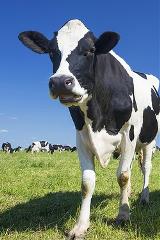Bovine Mastitis: Causes, Symptoms, and Detection

September 6, 2016
Mastitis can occur whenever udder tissue is invaded by infectious microbes, and the cause is typically due to contagious or environmental pathogens. It is important for a dairy herdsman to be aware of the methods of disease transmission, and the signs that indicate the animal needs veterinary treatment.
Sources of infection may include:
Causes
Most cases of mastitis involve one of the various species of streptococci and staphylococci encountered either during milking or from the cow’s environment.Sources of infection may include:
- Contaminated milking hands
- Dirty milking unit liners
- Improperly cleaned milking units
- Soiled bedding
- Polluted teat dip
- Dirty water used to clean udders prior to milking
- Pond water
- Mud holes
- Teat trauma
- Flies
Symptoms and Risk
When signs of mastitis become apparent, the infection can either be subclinical or clinical. The difference is dependent upon:- Duration of infection
- Host immune status
- Pathogen virulence
- Can infect one to all quarters at a time
- Shows no signs of local inflammation or systemic involvement outside of the presence of an infection indicated by brief periods of:
- Abnormal milk
- Udder inflammation
- Lasts for at least two months, then termed chronic mastitis
- If conditions of subclinical mastitis become established, some cows will carry infections that persist for their entire lactation, or even for their life.
- Symptoms typically occur in only one quarter at a time
- Mild or moderate clinical mastitis involves local signs, including:
- Visibly abnormal milk, indicated by:
- Fibrin clots
- Discoloration
- Visible changes to the udder as inflammation increases, including:
- Swelling
- Heat
- Pain
- Redness
- Hardness
- Severe clinical mastitis includes systemic involvement indicated by:
- Shock
- Fever
- Anorexia
- In severe clinical cases, when the onset of mastitis occurs rapidly, the cow’s condition is referred to as an acute case of severe mastitis.
- Season
- Age of animal
- Stage of lactation
- Previous episodes of infection.
- Adult lactating cattle:
- Mammary gland is the primary reservoir of infection
- Transmission of pathogens occurs mainly at milking, from hands or equipment
- Can affect animals either while lactating or when dry
- Heifers:
- Increased risk of infection through teat-end dermatitis caused by horn flies
Detecting Mastitis
One method used to detect mastitis involves examination of the milk for somatic cell counts (SCCs), a number that positively correlates with the presence of the infection. Tips to relate SCCs and a mastitis infection include:- Inflammatory udder changes and decreasing milk quality can be signaled by SCCs as low as 100,000 cells/mL
- Cows with SCCs of >280,000 cells/mL have a >85% chance of infection
- When the SCCs count is taken from the herd bulk tank, higher counts may signal higher prevalence of infection within the herd
- SCCs herd counts of <200,000 cells/mL are adequate, but lower counts can be attained.
Careers
Are you looking for a place to let your talents shine? At Covetrus, we help our practitioner customers better serve their patients and take pride in providing the best customer experience possible. Search our open positions to see our available opportunities.
Newsletter
Stay current with what’s going on with Covetrus, subscribe to receive our newsletter and email communications. Subscribers will receive the latest information in practice management, sales and marketing, animal health, and more.


Leave a comment